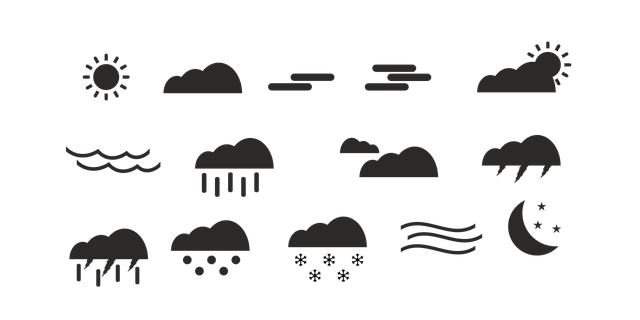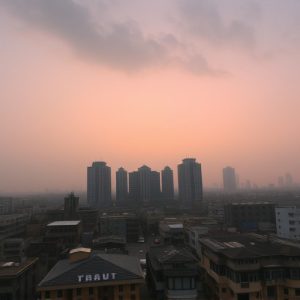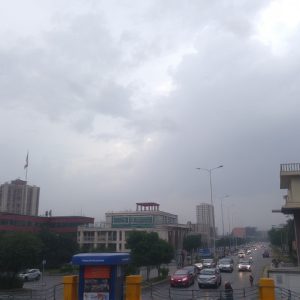Karachi’s Windy Dynamics: Monsoon Patterns, Topography, Urban Heat, and Climate Change
Karachi's weather is intricately tied to its geographical location and monsoon wind patterns. I…….

Karachi's weather is intricately tied to its geographical location and monsoon wind patterns. In summer, the southwest monsoon from the Indian Ocean brings humid air that triggers thunderstorms and strong winds, shaped by the Kirthar Mountains. In winter, these mountains channel northwesterly winds. The city's unique wind conditions result from the interaction between its coastal geography, which funnels winds from various directions into Karachi, and the seasonal monsoon shifts. The urban heat island effect intensifies with urban expansion, causing pronounced temperature increases that influence wind dynamics, with gusty winds during the day and nighttime cooling leading to land breezes. Sea breezes from the Arabian Sea cool the city during the day, while climate change is intensifying the Shamal winds, resulting in sandstorms and dust clouds, and altering monsoon patterns, leading to more unpredictable and severe wind events. Urban planners must adapt to these changes to ensure resilience against the effects of these evolving weather patterns.
Karachi, Pakistan’s economic hub, is renowned for its consistently windy conditions, a phenomenon that significantly influences the city’s climate. This article dissects the multifaceted reasons behind Karachi’s prevailing winds, from the monsoon wind patterns shaping the regional weather to the urban heat island effect intensifying airflow. The topography of Karachi’s coastal region and the interplay between sea and land breezes further contribute to the city’s windy nature. Additionally, the impact of climate change on these wind conditions is becoming increasingly apparent. As we explore these elements, we uncover a broader understanding of the meteorological dynamics at play in Karachi, shedding light on the natural forces that shape its environment and weather patterns.
- Prevailing Monsoon Wind Patterns
- Topographical Features of Karachi's Coastal Region
- Urban Heat Island Effect Amplifying Wind
- Sea Breeze and Land Breeze Interactions
- Climate Change and Its Impact on Karachi's Wind Conditions
Prevailing Monsoon Wind Patterns

Karachi, located on the Arabian Sea coast in Pakistan, experiences windy conditions predominantly due to the prevailing monsoon wind patterns. During the summer months, the city is influenced by the southwest monsoon flow originating from the Indian Ocean. This monsoon current brings humid and warm air masses towards the region, which upon encountering the cooler land surface temperatures, result in frequent and robust thunderstorms. These storms generate strong winds that can reach high velocities, often leading to the characteristic windy conditions experienced in Karachi. The topography of the region, with its proximity to the sea and the presence of the Kirthar Mountains to the northeast, further influences the wind patterns. The mountains act as a barrier, channeling the winds along specific paths, particularly the northwesterly winds that dominate during the winter months when the monsoon reverses. This complex interplay between the geography of the region and the large-scale atmospheric circulation is responsible for the prevalent wind conditions in Karachi. Understanding these patterns is crucial for meteorological forecasting, urban planning, and enhancing the resilience of infrastructure to withstand the effects of strong winds throughout the year.
Topographical Features of Karachi's Coastal Region

Karachi, situated on the Arabian Sea coast in Pakistan, is characterized by its unique topographical features that contribute to its windy conditions. The coastal region of Karachi is bordered by the Kirthar Mountains to the north and the Indus River delta to the northeast. These geographical elements create a natural funnel effect, where winds from the northwest and southeast converge over the city. The coastal topography, with its flat plains extending towards the sea, allows these winds to gain speed and intensity as they move inland, often resulting in brisk and sometimes gusty conditions throughout the city. Additionally, the proximity of the Arabian Sea amplifies the effects of the Shamal winds during the summer months, leading to increased humidity and stronger winds. The combination of these factors, including the local topography, oceanic influences, and prevailing monsoon winds, plays a pivotal role in shaping Karachi’s wind patterns and weather dynamics.
Urban Heat Island Effect Amplifying Wind

The urban heat island effect (UHI) plays a significant role in intensifying wind conditions in Karachi, Pakistan. This phenomenon occurs when urban areas, with their abundance of asphalt, concrete, and buildings, retain and release more heat than the surrounding rural areas. As Karachi continues to expand, the UHI effect becomes more pronounced, leading to elevated temperatures that alter atmospheric conditions. The heat absorbed by the city during the day accelerates local air currents, creating stronger thermal low-pressure zones. At night, the release of this stored heat drives the opposite, resulting in gusty winds as the cooler air rushes to replace the heated air. This diurnal cycle of heating and cooling contributes to the dynamic wind patterns characteristic of Karachi’s urban environment.
The interaction between the UHI effect and the city’s topography further amplifies wind conditions. Karachi’s coastline and proximity to the Arabian Sea influence its microclimate. The sea breeze, a wind system driven by temperature differences between the land and the sea, interacts with the heated urban air masses. This interaction can lead to the development of local wind patterns that are both stronger and more unpredictable due to the complex terrain and human-made structures within the city. The combination of these factors underscores the importance of considering urban development, climate patterns, and environmental interactions when understanding and managing wind conditions in Karachi.
Sea Breeze and Land Breeze Interactions

In Karachi, a city situated on the Arabian Sea coast, the interactions between sea breeze and land breeze are pivotal in shaping its windy conditions. During the day, as the land heats up more rapidly than the sea due to its higher albedo and urban heat island effect, a sea breeze is initiated. This maritime flow of air moves from the cooler sea towards the warmer land, which serves to moderate temperatures in the city. The sea breeze front, characterized by a sharp boundary between the air masses, can reach considerable speeds as it encounters less resistance over the open sea.
As the sun sets and the land cools down, the roles reverse; a land breeze begins to flow from the land outwards towards the sea. This nocturnal phenomenon is influenced by the cooling effect of the land surface and the gravitational pull of the moon and Earth, which intensifies pressure differences between the coastal area and the open sea. The land breeze is generally weaker than its counterpart, the sea breeze, but it plays a significant role in ventilating the city at night. The interaction of these two contrasting breezes contributes to Karachi’s unique wind patterns, affecting weather conditions and influencing local climate dynamics. The timing, strength, and trajectory of both breezes are affected by various factors such as the geography of the region, the specific coastal topography, atmospheric stability, and large-scale weather systems. Understanding these interactions is crucial for urban planning, environmental management, and improving the quality of life for Karachi’s residents.
Climate Change and Its Impact on Karachi's Wind Conditions

Climate change has a profound impact on weather patterns, including those in Karachi, Pakistan. The city, situated on the Arabian Sea coast, experiences varying wind conditions influenced by regional climate dynamics and global atmospheric shifts. Rising global temperatures have led to altered thermal contrasts between land and sea, which can intensify local winds. The warming trend has been associated with an increase in the frequency and intensity of strong winds known as the Shamal in the summer months. These northerly winds, originating from the Arabian desert, gain momentum due to the temperature differential and can cause sandstorms, dust clouds, and prolonged high-wind episodes that significantly affect air quality and living conditions in Karachi.
Furthermore, changes in monsoon patterns, attributable to climate change, have led to shifts in the timing and amount of rainfall. These alterations can influence wind behavior by affecting atmospheric pressure systems over the Indian Ocean and adjoining regions. The southwest monsoon, which brings moisture-laden winds to the region, can also bring about gale-force winds as it moves across the Arabian Sea towards Karachi. As the climate continues to change, the predictability of these patterns diminishes, potentially leading to more erratic and severe wind events in the future. This underscores the importance of monitoring and understanding these changes to prepare for and mitigate their effects on urban environments like Karachi.
Karachi’s prevailing wind conditions are a complex interplay of natural patterns, local topography, and the intensifying effects of urbanization. The monsoon winds, coastal topography, and the contrasting breezes play pivotal roles in shaping the city’s wind profiles. As urban development amplifies the urban heat island effect, the influence of these factors becomes even more pronounced. Additionally, climate change continues to alter these dynamics, underscoring the need for careful monitoring and adaptive planning. Understanding these elements is crucial for mitigating the challenges they pose and for ensuring the resilience of Karachi’s environment and its inhabitants in the face of ongoing environmental shifts.


